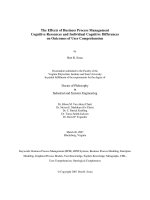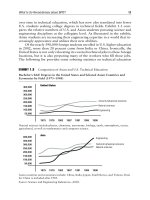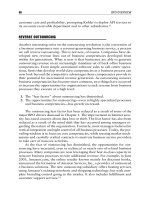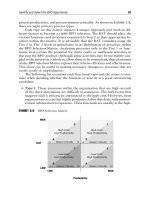Essentials of business process outsourcing by thomas n duening
Bạn đang xem bản rút gọn của tài liệu. Xem và tải ngay bản đầy đủ của tài liệu tại đây (1.19 MB, 243 trang )
4377_P-00(FM).qxd
1/31/05
12:42 PM
Page iii
ESSENTIALS
of Business Process
Outsourcing
Thomas N. Duening
Rick L. Click
John Wiley & Sons, Inc.
4377_P-00(FM).qxd
1/31/05
12:42 PM
Page vi
4377_P-00(FM).qxd
1/31/05
12:42 PM
Page i
ESSENTIALS
of Business Process
Outsourcing
4377_P-00(FM).qxd
1/31/05
12:42 PM
Page ii
Essentials Series
The Essentials Series was created for busy business advisory and corporate professionals.The books in this series were designed so that these busy professionals
can quickly acquire knowledge and skills in core business areas.
Each book provides need-to-have fundamentals for those professionals
who must:
• Get up to speed quickly, because they have been promoted to a new
position or have broadened their responsibility scope
• Manage a new functional area
• Brush up on new developments in their area of responsibility
• Add more value to their company or clients
Other books in this series include:
Essentials of Accounts Payable, Mary S. Schaeffer
Essentials of Balanced Scorecard, Mohan Nair
Essentials of Capacity Management, Reginald Tomas Yu-Lee
Essentials of Capital Budgeting, James Sagner
Essentials of Cash Flow, H.A. Schaeffer, Jr.
Essentials of Corporate Performance Measurement, George T. Friedlob, Lydia L.F.
Schleifer, and Franklin J. Plewa, Jr.
Essentials of Cost Management, Joe and Catherine Stenzel
Essentials of Credit, Collections, and Accounts Receivable, Mary S. Schaeffer
Essentials of CRM:A Guide to Customer Relationship Management,
Bryan Bergeron
Essentials of Financial Analysis, George T. Friedlob and Lydia L. F. Schleifer
Essentials of Financial Risk Management, Karen A. Horcher
Essentials of Intellectual Property, Paul J. Lerner and Alexander I. Poltorak
Essentials of Knowledge Management, Bryan Bergeron
Essentials of Patents,Andy Gibbs and Bob DeMatteis
Essentials of Payroll Management and Accounting, Steven M. Bragg
Essentials of Shared Services, Bryan Bergeron
Essentials of Supply Chain Management, Michael Hugos
Essentials of Trademarks and Unfair Competition, Dana Shilling
Essentials of Treasury, Karen A. Horcher
Essentials of Treasury and Cash Management, Michele Allman-Ward and
James Sagner
Essentials of XBRL, Bryan Bergeron
For more information on any of the above titles, please visit www.wiley.com.
4377_P-00(FM).qxd
1/31/05
12:42 PM
Page iii
ESSENTIALS
of Business Process
Outsourcing
Thomas N. Duening
Rick L. Click
John Wiley & Sons, Inc.
4377_P-00(FM).qxd
1/31/05
12:42 PM
Page iv
This book is printed on acid-free paper.
Copyright © 2005 by John Wiley & Sons, Inc., Hoboken, New Jersey.All rights reserved.
Published simultaneously in Canada.
No part of this publication may be reproduced, stored in a retrieval system, or transmitted
in any form or by any means, electronic, mechanical, photocopying, recording, scanning,
or otherwise, except as permitted under Section 107 or 108 of the 1976 United States
Copyright Act, without either the prior written permission of the Publisher, or
authorization through payment of the appropriate per-copy fee to the Copyright
Clearance Center, Inc., 222 Rosewood Drive, Danvers, MA 01923, 978-750-8400, fax
978-646-8600, or on the Web at www.copyright.com. Requests to the Publisher for
permission should be addressed to the Permissions Department, John Wiley & Sons, Inc.,
111 River Street, Hoboken, NJ 07030, 201-748-6011, fax 201-748-6008.
Limit of Liability/Disclaimer of Warranty:While the publisher and author have used their
best efforts in preparing this book, they make no representations or warranties with respect
to the accuracy or completeness of the contents of this book and specifically disclaim any
implied warranties of merchantability or fitness for a particular purpose. No warranty may
be created or extended by sales representatives or written sales materials.The advice and
strategies contained herein may not be suitable for your situation.You should consult with
a professional where appropriate. Neither the publisher nor author shall be liable for any
loss of profit or any other commercial damages, including but not limited to special,
incidental, consequential, or other damages.
For general information on our other products and services, or technical support, please
contact our Customer Care Department within the United States at 800-762-2974,
outside the United States at 317-572-3993 or fax 317-572-4002.
Wiley also publishes its books in a variety of electronic formats. Some content that appears
in print may not be available in electronic books.
For more information about Wiley products, visit our Web site at www.wiley.com.
Library of Congress Cataloging-in-Publication Data:
Duening,Thomas N.
Essentials of business process outsourcing / Thomas N. Duening, Rick L. Click.
p. cm. —(Essentials series)
Includes index.
ISBN 0-471-70987-5 (pbk.)
1. Contracting out. I. Click, Rick L. II. Title. III. Series.
HD2365.D84 2005
658.4′058—dc22
2004025808
Printed in the United States of America
10 9 8 7 6 5 4 3 2 1
4377_P-00(FM).qxd
1/31/05
12:42 PM
Page v
Contents
Preface
vii
1
The BPO Revolution
2
Identifying and Selecting the BPO Opportunity
33
3
Identifying and Managing the Costs of BPO
67
4
Vendor Selection and Contracting
97
5
Managing BPO-Related Change
135
6
Infrastructure Considerations and Challenges
173
7
Business Risks and Mitigation Strategies
195
Index
224
1
v
4377_P-00(FM).qxd
1/31/05
12:42 PM
Page vi
4377_P-00(FM).qxd
1/31/05
12:42 PM
Page vii
Preface
usiness process outsourcing (BPO) has emerged as one of the leading business and economic issues of our time. A natural extension
of the free-trade movement that has been a dominant force in
global economics over the past two decades, BPO has been met with
mixed reactions.Workers whose lives have been disrupted because their
jobs have been outsourced to lower-wage workers overseas have understandably decried “offshoring” as a threat to their way of life. Others,
especially those in the foreign locations where new jobs are rapidly being
created, are elated finally to have an opportunity to gainfully deploy
their hard-earned skill sets.
In this book, we attempt to examine BPO from the perspective of its
application and implementation in businesses of all sizes. We do not
address the political or economic controversies swirling around outsourcing. Instead, we assume that the movement of service work to lowest-cost providers, no matter where they may reside, will continue in
some form in the coming years. It seems unlikely that new barriers will
be erected that will seriously limit global free trade.With that in mind,
we have developed a rigorous methodology that businesses can use to
analyze the outsourcing opportunity, to make informed decisions about
choosing a vendor, and to manage change and execute an outsourcing
project.
B
vii
4377_P-00(FM).qxd
1/31/05
12:42 PM
Page viii
Preface
The team-based approach to BPO project analysis and management
that we recommend is based on the fact that BPO is a sociotechnical
phenomenon.That is, a well-executed outsourcing project must involve
both social and technical resources of the organization. BPO is transformational to the organization and requires attention to the social and
human impacts that accompany business transformation. At the same
time, one of the primary enablers of BPO is the set of technologies that
has emerged to connect the world in a global communications network.
As a sociotechnical phenomenon, effective BPO management requires a
diverse skill set that is not likely to be present in a single individual.Thus,
we recommend a team-based approach since the necessary skills are
more likely to be available in a group of people united to achieve common objectives.
We also develop the concept of the BPO Life Cycle to denote clear
milestones in development of the BPO project, and to provide more
specific management and leadership guidelines to be applied at different
stages of the Life Cycle.The BPO Life Cycle applies to any type of outsourcing project, and to any size company.
It has become clear that BPO provides far more than mere cost savings to firms that use it. BPO has become a strategic business choice that
can be leveraged for competitive advantage as well. When a business
outsources a process to a vendor whose core competence is centered on
that process, the buyer is likely to experience service enhancements that
can be turned into competitive advantages over rivals. Furthermore,
when the buyer–vendor relationship evolves into a business partnership,
both sides will be motivated to look for mutually beneficial ways to
leverage the combined asset pool.
As this book is going to press, outsourcing has become an important
new force in the global economy. It is our hope that the prescriptions,
guidelines, concepts, and tools provided in this book will be useful to
executives in organizations of all sizes as they struggle to determine their
viii
4377_P-00(FM).qxd
1/31/05
12:42 PM
Page ix
Preface
best opportunities for outsourcing. With the rapid evolution of outsourcing techniques and methodologies, we are certain that this book
only makes a dent in the growing understanding of BPO. At the same
time, there are timeless change and relationship management lessons in
this book that apply to outsourcing and to global, interorganizational
business relationships.We hope that readers will enjoy this book and that
it provides executives with insights and concepts to make informed decisions and choices.
TOM DUENING
RICK CLICK
March 2005
ix
4377_P-00(FM).qxd
1/31/05
12:42 PM
Page x
Acknowledgments
e want to thank the many individuals who contributed to this
book. Among those who were instrumental in its genesis are the
editors and writers we called upon for feedback and help on our
prose. Most significant among this group is Mr. Doug Williams of
Tomasini W2K in Houston,Texas. Doug’s assistance in editing and condensing this material was both instrumental and timely. In addition, our
Wiley editors Mr. Sheck Cho and Ms. Jennifer Hanley were very helpful and patient. Finally, we want to thank our families. My (TND) family put up with a lot of stress during the writing of this book as we
moved from Texas to Arizona. My daughters Jennifer and Tiffany and
my wife, Charlene, are my inspiration and foundation. My (RLC) move
from Texas to California also occurred during the writing of this book
and I thank my wife,Amy, for her patience during the process.
W
x
4377_P-01.qxd
1/31/05
12:30 PM
Page 1
CHAPTER 1
The BPO Revolution
O verview
The Internet bubble bursts, and the world keeps turning.Terrorists attack
the World Trade Center, and the world keeps turning.The global economy reels in the throes of a major recession, and the world keeps turning. Despite their unpredictable—and sometimes despicable—natures,
humans are nothing if not innovators and perpetual optimists. In the face
of doubt, ambiguity, and even terror, we continue to strive to build a better world.We are fortunate to be so resilient.
Even as our hopes for an easy peace and new economy prosperity in
the twenty-first century were dashed within months of its arrival, we continue our pursuit. Part of that quest is based on the technological breakthroughs that seemed to appear with breathtaking speed in the 1990s.
Standing on the shoulders of the innovators of the time, a new generation
of visionaries has leaped ahead. Of all the vast array of novelties introduced in the past few years, none is more important than the creation of
the global communications and information infrastructure that has now
burrowed into nearly every city, village, hamlet, and encampment around
the world. Fiber-optic cable spans oceans and continents. Low-earthorbit satellites provide streaming images, data, and voice to the most
remote locations. No place on earth, or in near-earth, is now beyond the
reach of the information and data nervous system that was constructed
1
4377_P-01.qxd
1/31/05
12:30 PM
Page 2
ESSENTIALS of Business Process Outsourcing
over the past few decades.This is revolutionary, and this nearly universal
telecommunications infrastructure is a major part of what gives life to the
business innovation called business process outsourcing.
B PO Defined
Business process outsourcing (BPO) is defined simply as the movement
of business processes from inside the organization to an external service
provider. With the global telecommunications infrastructure now well
established and consistently reliable, BPO initiatives often include shifting work to international providers. Five BPO international hot spots
have emerged, although firms from many other countries specialize in
various business processes and exporting services:
1. India. Engineering and technical
2. China. Manufacturing and technical
3. Mexico. Manufacturing
4. United States. Analysis and creative
5. Philippines. Administrative
Each of these countries has complex economies that span the range
of business activities, but from a BPO perspective, they have comparative
advantages in the specific functions cited.
A Strategy To Eliminate Noncore Functions
Because of the job shift that accompanies the quest to employ the highest-value talent, BPO has been both hailed and vilified. Business executives and owners praise it as a way to eliminate business processes that are
not part of their organization’s core competence. Back-office functions,
such as payroll and benefits administration, customer service, call center,
and technical support, are just a few of the processes that organizations
of all sizes have been able to outsource to others who specialize in those
2
4377_P-01.qxd
1/31/05
12:30 PM
Page 3
The BPO Revolution
areas. Removing these functions from their internal operations enables
organizations to reduce payroll and other overhead. In an era when executives have been admonished by business commentators and analysts to
focus on core competencies, BPO offers an opportunity to achieve that
goal in a dramatic new way.
Like appliance manufacturers that moved production from the Midwest to Mexican maquiladoras or apparel firms that moved production to
the Far East, businesses of all types and sizes are now shifting back-office
jobs to international locations such as China, India, and the Philippines,
where labor is inexpensive and highly skilled. In the past several years,
companies have turned to these regions for increasingly sophisticated
tasks such as financial analysis, software design, tax preparation, and even
the creation of content-rich products (e.g., newsletters, PowerPoint presentations, and sales kits).
BPO Not Confined To Routine Jobs
With the increasing education levels around the world, BPO is no longer
confined to routine manufacturing jobs or boiler-room telemarketing
centers.Today’s outsourcing involves complex work that requires extensive preparation and training. For example, Indian radiologists now analyze computed tomography (CT) scans and chest X-rays for American
patients out of an office park in Bangalore. In the United States, radiologists are among the highest-paid medical specialists, often earning more
than $300,000 per year to evaluate magnetic resonance imaging (MRI),
CT scans, and X-rays. In Bangalore, radiologists work for less than half
that. Not far from the radiology lab in Bangalore, Ernst & Young has 200
accountants processing U.S. tax returns. Starting pay for an American
accountant ranges from $40,000 to $50,000; in Bangalore accountants
are paid less than half that.1
3
4377_P-01.qxd
1/31/05
12:30 PM
Page 4
ESSENTIALS of Business Process Outsourcing
Outsourcing of Service Jobs to Escalate
In the next 15 years, Forrester Research predicts that 3.3 million service
jobs will move to countries such as India, Russia, China, and the Philippines (Exhibit 1.1).That is the equivalent of 7.5 percent of all jobs in the
United States right now.2
Estimates from leading research firms more than support this trend.
The Gartner Group, a Stamford, Connecticut-based research firm, predicts that:
• One in ten jobs at specialty information technology (IT) firms
in the United States will move abroad by 2005, along with one
in 20 IT jobs in general businesses—a loss of about 560,000
positions.
• BPO will reach $178 billion in revenues worldwide by 2005,
representing a compound annual growth rate of 9.2 percent for
the five-year forecast period.3
EXHIBIT 1.1
Jobs Expected to Shift Overseas
3,500,000
Total
3,000,000
Office
Computer
2,500,000
Business
2,000,000
Management
Sales
1,500,000
Architecture
1,000,000
Legal
Life Sciences
500,000
Art/design
2000
2005
2010
4
2015
4377_P-01.qxd
1/31/05
12:30 PM
Page 5
The BPO Revolution
Additionally, market research firm IDC predicts that finance and
accounting outsourcing will grow to nearly $65 billion by 2006, up from
$36 billion in 2001. Two thirds of U.S. banks already outsource one or
more functions.4
BPO has caught on as well with the venture capital community. In
2002, venture capital firms in North America poured nearly $3 billion
into BPO firms and nearly $1 billion more by June 2003. Some BPO
providers enjoy operating profit margins as high as 40 to 50 percent.
Even though margins are expected to level out to between 20 and 25
percent as the market matures, these returns are greater than those being
experienced in nearly any other industry.5
Concerns Over Job Losses
Despite this, BPO is not without its critics. There is no doubt that the
history of outsourcing in manufacturing has been black-marked by the
many Americans who lost their jobs and cannot find new ones in the traditional manufacturing sector. Today, everything from electronics to
home furnishings is being produced by low-cost labor in places such as
Shanghai and Monterrey.The prediction that free-trade agreements such
as the North American Free Trade Agreement (NAFTA) would create a
“giant sucking sound” as jobs moved to low-wage labor environments
has rung true for many U.S. workers. Factories across the country,
including many staples of America’s industrial past, have gone silent—
apparently for good.
Although such wrenching change is painful and unsettling, the
resilience of the American worker to find new ways to create value in a
global economy shows few limits. As the nineteenth century’s Agrarian
Age came to an end and workers moved from farms to factories, they
adapted and built some of the greatest cities in the world. At the end of
the twentieth century, the Industrial Age gave way to the Information
Age, and many workers moved out of factory jobs into information-rich
5
4377_P-01.qxd
1/31/05
12:30 PM
Page 6
ESSENTIALS of Business Process Outsourcing
I N T HE R EAL W ORLD
Does BPO Increase the U.S.
Unemployment Rate?
The Labor Department, in its numerous surveys of employers and
employees, has never tried to calculate the number of jobs that are
shifted overseas as a result of BPO. But the offshoring of work has
become so noticeable that experts in the private sector are trying to
quantify it. Initial estimates are that at least 15 percent of the 2.81
million jobs lost in America since the recession began have reappeared overseas. Productivity improvements at home account for
the great bulk of the job loss. But the estimates suggest that work
sent offshore has raised the U.S. unemployment rate by four tenths
of a percentage point or more.
Among economists and researchers, one high-end job-loss estimate comes from Mark Zandi, chief economist at Economy.com,
who calculates that 995,000 jobs have been lost overseas since
the recession began in March 2001. That is 35 percent of the
total decline in employment since then. Most of the loss is in
manufacturing, but about 15 percent is among college-trained
professionals.
Source: Adapted from Louis Uchitelle, “A Missing Statistic: U.S. Jobs that Went
Overseas,” The New York Times (October 5, 2003).
occupations and built some of the greatest technologies in the world.
There is every reason to believe that BPO will help create a more tightly
integrated business world that will lead to a more tightly integrated cultural and economic world. BPO has the potential to create new prosperity for workers everywhere through participation in a BPO-based
business superculture that spans the globe.
6
4377_P-01.qxd
1/31/05
12:30 PM
Page 7
The BPO Revolution
B PO: A Sociotechnical Innovation
Many executives and managers shy away from BPO because they wrongly
believe it to be a technical innovation—one better left for the chief
information officer (CIO) or other technology administrators. In part,
this belief results from the IT origins of BPO. Many early adopters of
outsourcing were those who needed software development expertise or
who sought technical expertise to staff help desks and call centers. During the 1990s, the labor pool for such talent in the United States was
tight, prompting many leading companies to search abroad for the personnel they needed. These organizations turned to international labor
markets, where they were able to identify and hire highly skilled technical workers who were far cheaper than their U.S.-based counterparts.
Today, the talent shortage in the United States has abated, but the cost
savings to be gained by using outsourced talent remains.
BPO Transcends IT Origins
BPO has evolved far from these IT-specific roots and now encompasses
nearly every business process.To be sure, the implementation of a BPO
initiative will always involve a technology component, but for that matter so does implementation of a benefits administration office at the
local beer distributor.The point is, nearly every modern business innovation comprises both a technical and a social component. Decision
making, strategy setting, service delivery, and virtually every other business activity are now sociotechnical in nature, involving humans interfacing with technical systems. BPO is like that.
Fundamentally, then, BPO is a sociotechnical business innovation
that provides a rich new source of competitive advantage. By sociotechnical we mean that BPO requires skillful management of people and
technology (hardware and software).The manager who initiates a BPO
strategy must find effective ways to introduce people to technology and
7
4377_P-01.qxd
1/31/05
12:30 PM
Page 8
ESSENTIALS of Business Process Outsourcing
vice versa. If left solely in the hands of technical specialists, a BPO initiative is likely to fail for lack of paying attention to the soft issues of
human relationships, change management, and organizational culture. If
left solely in the hands of nontechnical managers, it is likely to fail for
unrealistic expectations about the potential and limitations of the
enabling technologies.
Human Factors and Technology Issues
BPO is one of those interdisciplinary workplace innovations that demands
a diverse set of skills to be successful. Initiating and implementing a BPO
project requires a focus on several human factors, both within the organization initiating the project and within the outsourcing vendor.These
factors cannot be ignored and must be handled correctly in order for the
project to succeed. Human factors include:
• Developing various teams to manage the BPO initiative
throughout its life cycle
• Reassuring staff of their role in the company
• Training people on the new way of doing business
• Dealing with job loss and/or reassignment
• Keeping morale high throughout the change process
• Encouraging people to participate in decision making
• Understanding cultural differences between the organization
and BPO partner
The initiation and implementation of a BPO project also requires
attention to technology issues such as:
• Compatibility of systems between the BPO buyer and vendor
• Data and system security
• Backup and recovery procedures in the case of system failure
8
4377_P-01.qxd
1/31/05
12:30 PM
Page 9
The BPO Revolution
• Data interface challenges and strategies
• Software and database compatibility challenges
• Data and knowledge management
These various issues will be discussed at some length in Chapter 6.
D riving Factors
Scholars who study how complex systems change over time are familiar
with two types of change:
1. Evolutionary, which are changes a system is likely to produce based
on its current design and goals
2. Emergent, which are system features or capabilities that would not
have been predicted in advance based on the understood design
and goals of the system.
BPO is revolutionary because it is such an emergent phenomenon
and because there is no evidence that anyone set out to design the
potential for organizations to use BPO. It grew from a set of driving factors, illustrated in Exhibit 1.2, that have unintentionally converged at this
particular time to enable the shifting of work to its lowest-cost/highestquality provider regardless of the provider’s physical location. BPO is a
business innovation that leverages these driving factors and applies them
to practical business problems.
A discussion of each of these drivers follows.
Educational Attainment
The United States remains the global leader in higher education, but the
rest of the world is catching up quickly. As more and more Ph.D.qualified faculty return to their home countries with degrees from Harvard, MIT, Stanford, and other prestigious schools, they are helping to
9
4377_P-01.qxd
1/31/05
12:30 PM
Page 10
ESSENTIALS of Business Process Outsourcing
EXHIBIT 1.2
BPO Drivers
Business
Specialization
Broadband
Internet
Educational
Attainment
THE BPO
REVOLUTION
Internet
Security
Inexpensive
Data Storage
Online
Analytic
Processing
transform higher education worldwide.At the K–12 level, it has long been
noted that the United States lags other countries, especially in technical
areas such as math and science as measured by standardized test scores.The
gap between the United States and many foreign nations has increased
over time in technical education, which now also translates into fewer U.S.
students seeking degrees in technical fields. In Asia, for example, far more
students are pursuing science and engineering disciplines at the collegiate
level than are their counterparts in the United States (Exhibit 1.3). Clearly,
10
4377_P-01.qxd
1/31/05
12:30 PM
Page 11
The BPO Revolution
EXHIBIT 1.3
Comparison of Asian and U.S.
Technical Education
Bachelor’s S&E Degrees in the United States and Selected Asian
Countries and Economies by Field (1975–1988)
400,000
United States
350,000
300,000
250,000
200,000
Social & behavioral sciences
150,000
Natural sciences
100,000
Engineering
50,000
1975
1979
1983
1987
1991
1995
1998
Natural sciences include physics, chemistry, astronomy, biology, earth, atmospheric, ocean,
agricultural, as well as mathematics and computer science.
400,000
Asia
Engineering
350,000
Social & behavioral sciences
Natural sciences
300,000
250,000
200,000
150,000
100,000
50,000
1975
1979
1983
1987
1991
1995
1998
Asian countries and economies include: China, India, Japan, South Korea, and Taiwan. Data for
China is included after 1983.
Source: Science and Engineering Indicators—2002.
11
4377_P-01.qxd
1/31/05
12:30 PM
Page 12
ESSENTIALS of Business Process Outsourcing
they recognize that the business world increasingly appreciates and utilizes
their new abilities.
Of the nearly 590,000 foreign students enrolled in U.S. higher education in 2002, more than 20 percent came from India or China. Ironically, the United States is not only relocating its coveted technical jobs to
these foreign locations, but also preparing many of the workers who fill
those jobs.The following list provides some sobering statistics on technical education worldwide that indicates why so many U.S. firms are
looking abroad for the talent they need to be competitive:
• In 2001, 46 percent of Chinese students graduated with engineering degrees; in the United States, that number was 5
percent.
• Europe graduates three times as many engineering students as
the United States;Asia graduates five times as many.
• In 2003, less than 2 percent of U.S. high school graduates went
on to pursue an engineering degree.
• In 2001, almost 60 percent of those earning Ph.D.s in electrical
engineering in the United States were foreign born.
• Among the more than 1.1 million seniors in the class of 2002
who took the ACT college entrance exam, fewer than 6 percent planned to study engineering, down from 9 percent in
1992.
• Less than 15 percent of U.S. students have the math and sci-
ence prerequisites to participate in the new global high-tech
economy.
• In the United States, more students are getting degrees in parks
and recreation management than in electrical engineering.6
It now makes sense for U.S. firms to rely on foreign providers of
highly skilled labor.The logic is simple:The quality of talent is high and
the cost is low. Educational attainment around the world will drive BPO
innovators to seek new ways to tap that talent. There is no way to put
12









